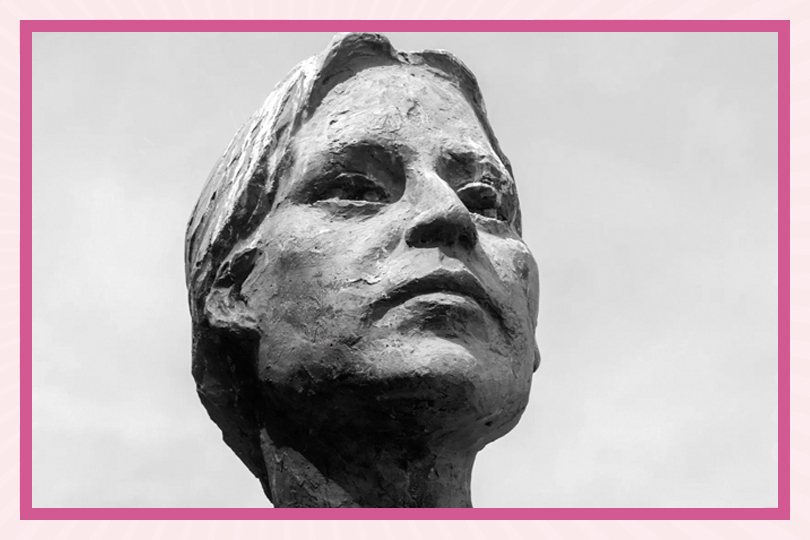Part of a new series of profiles that bring to life the forgotten stories of bold and inspiring women in history.
By Sienna Vittoria Asselin
Molly Brant was one of the most powerful women of eighteenth-century North America. As a clan leader, skilled diplomat, and devoted mother and partner, Molly earned her place as an important figure in pre-Confederation Canadian history. Read on to learn more about her fascinating life and legacy.
Early years
Although the details around her early years are hazy, most historians agree that Mary (Molly) Brant was born in 1736 in the Mohawk Valley in New York, then still under British rule. Her birth name was Gonwatsijayenni, meaning “someone lends her a flower.” Some believe her father was a powerful chief, while others say that her father was a Christian convert named Peter, and that it was through her mother that she was a descendent of a chief of the Mohawks, one of the Six Nations of the Iroquois Confederacy.
Either way, she was born to a prominent Mohawk family that held a lot of political clout in the region.
After her father died, Molly’s mother, Margaret, remarried. Molly and her brother Joseph went to live with their new stepfather, a Mohawk-Dutch man named Nickus Brant Canagaradunska, in Canajoharie (New York). They assumed his surname and she received a European education, likely attending a Protestant mission school nearby and learning to read and write in English, which was to prove useful in her later years.
A young diplomat
Unlike their white settler counterparts, Mohawk women were responsible for appointing the chief and wielded great economic and political power, controlling the food supply and vetoing warriors’ decisions.
As a teenager, Molly was already respected for her keen political savvy. Her diplomatic skills were put to the test when she was 18 years old—perhaps as part of her training in the Iroquois tradition to become a clan matron—when, in 1754-55, she joined a delegation of 12 Mohawk elders. They travelled to Philadelphia to deal with the issue of fraudulent land transactions, and she was able to play a role in the discussions.
For Molly, this was just the beginning of a long career as a diplomat and leader in her community.
And then comes marriage
According to tradition, while attending a military gathering, Molly leapt upon the back of a horse behind an officer and hung onto him as the horse dashed about the field, to the great amusement of onlookers. This daring move caught the attention of Sir William Johnson, one of the most prominent politicians in the area.
After this quirky meet-cute, Molly and Sir William’s relationship quickly progressed and in 1759, they began to live together, and she gave birth to their first of many children. They were technically not legally married in the Christian European tradition, but from what we can tell, they lived together as man and wife in what we would now think of as a loving and committed common-law arrangement.
A bridge between peoples
Molly quickly became closely involved in her husband’s political career. Sir William was a respected Irish landowner, successful businessman, a friend of the Iroquois, and was appointed “Superintendent of Indian Affairs”, the government official in charge of relations between the Crown and the Indigenous peoples of the colonies. Because of her important family connections among the Iroquois and her position as a Clan Mother, she often played an important role in Sir William’s negotiations. And during his many absences, she shrewdly managed his estates.
She was equally at home among the white settlers and the Mohawks, and while she could speak and write English well, she was proud of her heritage and continued to speak Mohawk and dressed in traditional Mohawk fashion all her life and she encouraged her children to do the same.
Woman of the revolutionary war
In 1774, Johnson died, and Molly returned to Canajoharie (where she grew up with her stepfather) with her children. There, she was still a respected woman in her own right.
When hostilities broke out between Great Britain and the American colonies, who were eager for their independence from British rule, she started to shelter and feed British loyalists hiding in the woods and supplied them with arms and munitions.
In 1777, she sent a messenger to warn the British forces that the Americans were planning a nearby attack. With this intelligence, the loyalists were able to ambush the approaching American militia. This made her and her people a target of the Americans and their allies, and she managed to escape just before her home was attacked and plundered.
She moved to Cayuga (New York), where she continued to negotiate with politicians and chiefs alike. She attended council meetings and counselled various chiefs, rebuking one particularly powerful war chiefs for considering peace with the Americans.
Later, a British major invited her to move to the military base at Fort Niagara, where she focussed her efforts on encouraging the Six Nations of the Iroquois Confederacy to support the British side. As the head of a society of Six Nations matrons, and the widow of Sir William, she had a particularly influential position. It was recorded that her influence was “superior to that of all their Chiefs together.”
A loyalist’s legacy
In 1779, many Mohawks lost their villages and crops due to the war and were forced out by the American troops. She continued to act as a diplomat but also petitioned on behalf of her people, complaining when she felt that the Iroquois were being ignored by the government in the aftermath of the war.
She joined some of the loyalists on Carleton Island, then moved to Montreal, and by the end of the war, like many others, Molly moved to Upper Canada, settling in Cataraqui (Kingston, Ontario), where she remained until her death.
The British government awarded her a substantial military pension for her wartime services, and she lived with her daughters very comfortably and in a position of respect among the English community. She was a regular dinner guest at the Lieutenant-Governor’s house, was very involved in the Anglican Church (she was the only woman listed on the founding charter of 1792) and she continued to promote the interests of the Mohawk people.
Though fascinating, her story of bravery and political influence is largely unknown. Molly was a strong woman of her own unique and complex personal convictions. Perhaps one of the reasons she has been forgotten in history is that nobody knows where to place her—she was both genuinely pro-Mohawk and pro-British. Throughout her life, she stood for what she believed in with passion and courage.
Fortunately, her legacy has begun to garner some attention and she is starting to get the recognition she deserves. In 1986, Canada Post honoured her with a limited edition series of stamps illustrated with her portrait. Furthermore, she is recognized as a person of national historic importance and a plaque celebrating her story can be found in Kingston.











